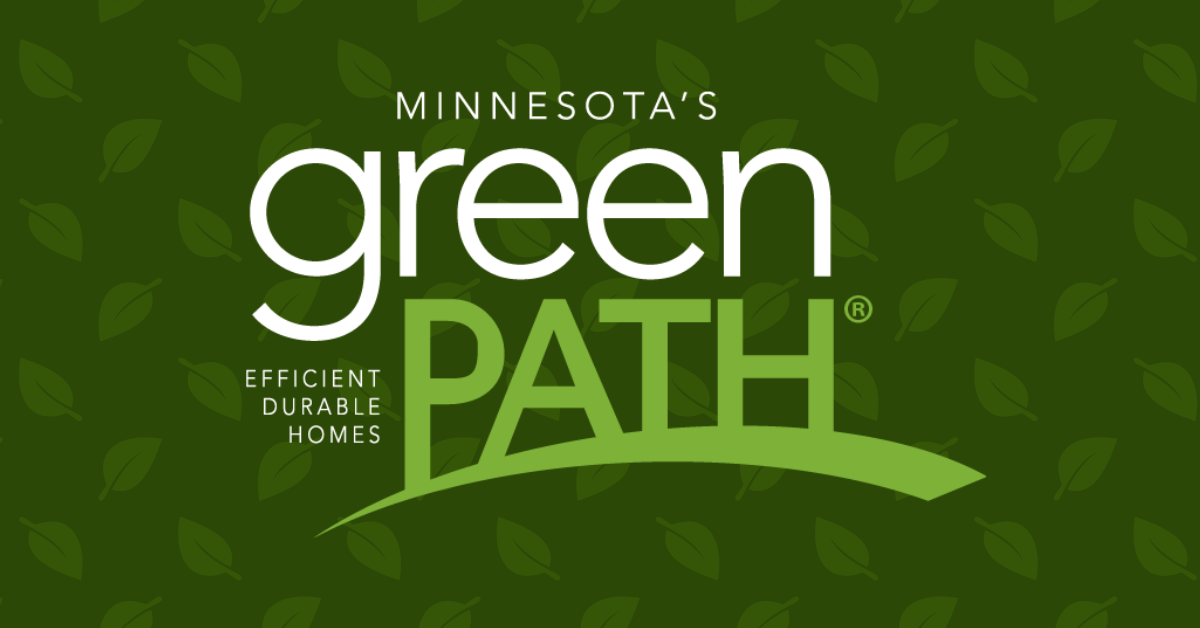For 10 years, Minnesota’s Green Path program has been certifying newly built homes across the state.
Created by Housing First Minnesota in 2011, Minnesota’s Green Path is the leading energy efficiency and green building program for the residential construction industry in Minnesota. The program was designed to appeal across a broad market by providing transparency and independent verification. It also offers certification for improved energy efficiency and home performance.
“For a decade we’ve been working to highlight Minnesota’s leadership in energy-efficient homes through our Green Path program,” said David Siegel, executive director of Housing First Minnesota. “We’re proud to see our builders embrace sustainable building practices and incorporate construction techniques, materials, and designs intended to provide maximum home comfort while conserving energy and minimizing a home’s impact on the environment.”
Minnesota’s Green Path provides builders and consumers with Home Performance Reports (HPRs) that highlight a home’s RESNET Home Energy Rating System (HERS) index and air exchange measurement. The lower the HERS index, the more energy-efficient the home.
The program has now provided HPRs to more than 29,000 new homes. These HPRs are the heart of the program, providing homebuyers with test results from independent, third-party RESNET raters in an easy-to-understand and compare format.
“That’s the value of that Home Performance Report—it’s not us just telling our homeowners about how the insulation is or what the HERS index is, we actually have a physical piece of paper or a physical example to say here is proof of what we’ve done as a builder,” said Carole Griffith, vice president of sales and marketing for Robert Thomas Homes and chair of the Minnesota Green Path program, on a recent podcast. “That third-party verification and the Home Performance Reports are, I think, really the key.”
Minnesota’s Green Path Designation Levels
Minnesota’s Green Path offers three certification levels, with Advanced and Master levels requiring elevated efforts in all five green building aspects (energy efficiency, environmental quality, water management, resource management, and site/development). These levels were created to allow builders to help their buyers choose exactly the level of energy efficiency that fits their philosophy and their budget.
Energy Tested: This is the base level of Minnesota’s Green Path. These homes have been tested and rated by a third-party, independent RESNET Rater, are built to Minnesota’s energy code, receive a HERS index, and are issued an HPR that allows consumers to better understand the home’s efficiency.
Advanced Certified: This mid-level green certification means a home has met a minimal energy testing standard, plus includes additional green features. These homes are tested and rated by a third-party, independent RESNET Rater and receive a HERS index of less than 47. These homes are built to Minnesota’s energy code, plus meet:
• 5 points in energy efficiency
• 5 points in indoor environmental quality
• 5 total points from water conservation, resource management, or site development
• 5 total points from any of the five categories
Master Certified: This top-level green certification means a home has met a high energy testing standard, plus includes additional green features. These homes are tested and rated by a third-party, independent RESNET Rater and receive a HERS index of less than 45. These homes are built to Minnesota’s energy code, plus meet:
• 10 points in energy efficiency
• 10 points in indoor environmental quality
• 10 points in water conservation
• 10 total points in resource management
• 10 total points in site development
Program Growth
When Green Path launched in 2011, 11 homes on the Parade of Homes fall tour were Green Path Energy Tested. Today, more than 290 homes on the spring tour were Green Path Energy Tested. This year, Green Path will certify its 30,000th home.
In addition to issuing HPRs at three certification levels, the Green Path program expanded by launching the Green Path Building Conference in 2015, a half-day educational conference where attendees learn about the latest energy-efficient building techniques. And in 2019, the program began offering the Designated Green Path Builder program to industry leaders in energy-efficient residential home construction. Designated Green Path Builders commit to test at least 75% of their homes and attend required professional development. Currently, 40 builders have earned this designation.
Minnesota’s Green Path has grown through the support of homebuilders throughout the state who were eager to show their commitment to creating a sustainable program that leads the country in energy efficiency, all while balancing affordability for homebuyers across the state.
“I think ultimately, not only is it benefiting our customers as a whole, but we’re also doing the right thing,” said Griffith. “We’re doing the right thing for environment, for our community, and our homeowners get to see the long-term benefits of that.”

















